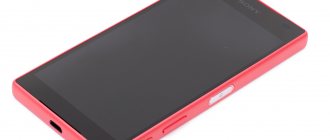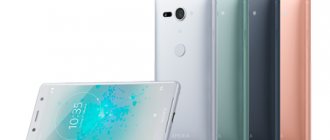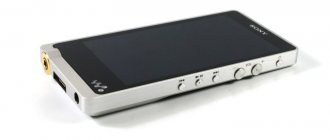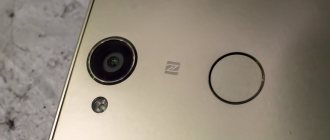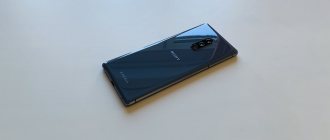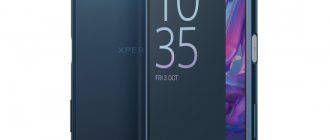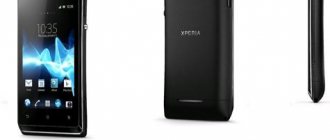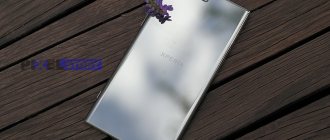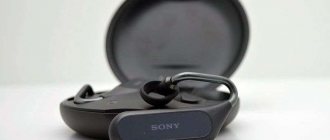Technical characteristics of Sony Xperia X Compact:
- Screen: 4.6″, Triluminos, 1280×720, 319 ppi
- Processor: six-core Qualcomm Snapdragon 650, up to 1.8 GHz
- Graphics accelerator: Adreno 510
- Operating system: Android OS 6.0
- RAM: 3 GB
- Built-in memory: 32 GB
- Memory card support: microSDXC up to 256 GB
- Communication: GSM 900/1800/1900 MHz || UMTS 850/900/1900/2100 MHz || LTE 1, 3, 7, 20, 31, 38
- SIM: nano-SIM
- Wireless interfaces: Wi-Fi 802.11 a/b/g/n/ac, Bluetooth 4.2, NFC, FM receiver
- Navigation: GPS, GLONASS
- Cameras: main - 23 MP (flash, hybrid AF), front - 5 MP (fix focus)
- Sensors: light, proximity, fingerprint, microgyroscope, accelerometer
- Battery: 2700 mAh, non-removable
- Dimensions: 129x65x9.5 mm
- Weight: 135 grams
Buy a smartphone
Sony Xperia Z1, Z3, Z5 Compact specifications and comparison
Sony Xperia Z1 Compact | Sony Xperia Z3 Compact | Sony Xperia Z5 Compact |
|
|
|
Xperia Z1 Compact and Xperia Z3 Compact
These two devices were released in 2014 and were equipped with two excellent processors for that time, Snapdragon 800 and 801. Their AnTuTu benchmark scores ranged from 39 to 42 thousand points. This was a fairly large number, and the chipsets easily allowed the device to run demanding games and perform a variety of tasks. Also, the smartphones were equipped with 2GB of RAM, thanks to which the devices felt as confident as possible in operation. But the graphics chip in the phones was the same - Adreno 330. This is also quite a strong monster for 2014, thanks to which smartphones could cope with demanding games. For example, the Xperia Z1 and Z3 Compact could run GTA: San Andreas without any problems at maximum graphics settings. And this is a rather difficult game, which some modern smartphones cannot handle.
Sony Xperia Z1 Compact
The display of the Sony Xperia Z1 Compact is quite small and this is not surprising. Its diagonal is 4.3″ and the pixel density is 342ppi with HD resolution. These are quite good indicators for this size. But in the Z3 Compact, the screen diagonal was increased to 4.6 inches, and the pixel density was reduced to 319ppi, from which we can conclude that pixels are slightly visible in the image. But this is not a problem, because its quality itself is at a fairly high level, the picture is quite rich and does not lose its color when viewed from different angles. Of course, there are some drawbacks, despite the fact that the maximum brightness is more than enough to use the phone in the sun, but the minimum brightness is very weak.
The camera in these two smartphones is excellent, as much as 20MP and a sensor from Sony. Thanks to two powerful Snapdragon 800 and 801 processors, the camera reaches its full potential and can capture high-quality images. For that time, these two smartphones took excellent photos, even at night the images were clear and detailed, without any noise. Video shooting is also good; thanks to the f/2.0 aperture and optical stabilization, the video is clear and high-quality both day and night.
Sony Xperia Z3 Compact
But the appearance of smartphones is practically no different, except perhaps in size. The body is made of glass and metal, and does not look like the vast majority of devices, but on the contrary - people see that it is really Sony, because no well-known manufacturer makes smartphones with this design. The back and front panels are made entirely of glass, and the sides are made of metal. Smartphones have a round lock button, which is one of Sony's features. In addition to the usual USB charging port, the manufacturer has added to its smartphones the ability to connect magnetic charging, which most devices also do not have. Also, it is worth noting that the Sony Xperia Z1 Compact has an IP58 protection standard, and the Z2 Compact has an IP68 protection standard. This is of course very good, but many did not like that the manufacturer did not make a plug for the mini-jack. After all, if the phone has been in water, then it is not advisable to connect headphones in the next 30-40 minutes.
Xperia Z5 Compact
This device is worth considering separately, because despite the fact that it is very similar to the previous two, it has much more serious brains than the Z1 and Z3 Compact. Sony Xperia Z5 Compact was released in 2020 and was equipped with an eight-core Snapdragon 810 processor. It scores about 80 thousand parrots in AnTuTu and this number cannot but rejoice. But this was not the top chipset of 2020, because later they released the Apple A9x, which scored about 170 thousand points. But since we are considering a smartphone in a much lower price category, we can say that Snapdragon 810 is the ideal chipset for such a smartphone. It is almost twice as powerful as the previous two. Also, a newer graphics chip was introduced into the smartphone - Adreno 430. This filling is ideal even for 2018 and the phone will be able to cope with absolutely any task. But unfortunately, if you use it now, you will most likely not have enough RAM.
The rest of the smartphone is similar to the Sony Xperia Z3 Compact. Exactly the same screen, similar design and almost the same camera. Only now it’s 23MP, but with the same f/2.0 aperture. Unfortunately, the manufacturer did not indicate the exact sensor, but looking at examples of smartphone photography, we can conclude that the camera has become much better. Images are richer and more detailed, and the photo feels more realistic. Video shooting has become much better. Now the smartphone can shoot video in FullHD at 60 frames/s. Also, optical stabilization has begun to work better, the number of jerks has decreased, and the user will be able to see beautiful and smooth video.
Otherwise, the smartphone is no different from the two previous devices, except that the battery has become 2700 mAh.
Design
As the review of the Sony Xperia X Compact smartphone showed, the appearance has changed a lot if we compare it with other models of the manufacturer’s current line. The body materials became a victim of economy - plastic was used instead of pleasant tactile metal. The case turned out to be quite thick - as much as 9.5 mm. But the 4.6-inch diagonal makes it very practical and compact, especially in comparison with 5.5 and 6-inch devices. It's like the iPhone SE, but only from Sony.
The front side is covered with Gorilla Glass, which has rounded edges.
The sides of the display are surrounded by frames almost 2 mm wide. The central space above it is occupied by the Sony logo, and even higher is a narrow speaker mesh, and in the right corner is a notification light. Also on the sides are sensors and a selfie camera lens.
The space below was left empty, it is occupied only by the mesh of the second speaker. In combination with the main one, it was possible to achieve a high-quality stereo sound effect. Navigation keys take up space at the bottom of the screen; they are software. In settings, you can set which apps will not display them in order to make the most of your display area.
The Xperia X Compact smartphone has an all-metal body, which means the cover cannot be removed. Its upper left corner is occupied by the main camera sensor, and to the right is laser focusing, LED flash and RGBC-IR sensor. The NFC chip and the Xperia logo are located in the center.
A flat power control key, slightly recessed into the body, was installed on the right side. It is located in the center and clearly falls under the finger. In addition to its main purpose, it plays the role of a fingerprint scanner. Below we see a volume rocker and a separate shutter button.
On the left there is a tray in which you can put nanoSIM and microSD. It is located under a plug that opens very easily, just pry it off with your fingernail. As the Sony Xperia X Compact f5321 review showed, the smartphone, contrary to all expectations, did not receive moisture protection. There is no hot swap option; as soon as you open the tray, the system reboots.
The USB Type-C port is installed at the bottom, except for it there is only a microphone hole.
On top there is a 3.5 mm mini-jack and an additional microphone.
The build quality of the case is excellent - holding it in your hands gives the impression of reliability. It fits very well in the hand, which is due to the rounded corners and small width of the case. The back and front panels cause some concern, but in reality they are not slippery. You can reach any part of the display or functional element with one hand.
⇡#Appearance, ergonomics and software
Sony Xperia X Compact, as I noted above, is made according to the same Loop Surface design code as the Xperia XZ - with edges that visually flow into each other, the same bend of the front panel and back, curved side panels, but absolutely flat top and bottom. At the same time, the general impression that appeared when looking at the Z5 Compact was preserved - the new product also seems too thick. And this is not an illusion: nine and a half millimeters - we haven’t seen this for a long time.
Another solution that may cause controversy is the use of glossy plastic. Smartphone manufacturers seem to have stopped mocking the public and are no longer trying to stupidly embellish reality - no one calls the material used here a special type of polycarbonate. Plastic is plastic. And, to my taste, it looks quite good, although the white X Compact makes me think of Chinese crafts from the 2000s. At a time when even those same Chinese manufacturers of budget smartphones clad their devices with metal, such a decision seems bold, turning everything upside down.
Sony Xperia X Compact, front panel: both above and below the screen there are stereo speakers, the top one is active in conversation mode; also on top – front camera lens and light sensor
But the white version is very convenient if you are not too fond of wearing cases or constantly wiping your gadgets. Glossy plastic is generally a very easily soiled material, but in this case nothing is noticeable; the smartphone will look like new for a very long time.
Sony Xperia X Compact, rear panel: in the upper left corner there is a camera lens, a single LED flash, an infrared sensor and a contrast focusing laser
The main reason for which the X Compact was actually created is its dimensions. The usual cliched phrases about the convenience of one-handed operation look more appropriate here than ever. If suddenly a person who is accustomed to the iPhone (but despised the Plus version) wants to switch to Android, then switching to the “compact” will probably be the easiest way. It’s not even worth talking about the fact that a smartphone fits into any pocket freely and easily. In a lady's handbag - naturally, too. And the delicate colors of the case in which the smartphone is offered hint that quite a few copies of the X Compact will most likely end up there.
Sony Xperia X Compact, top edge: mini-jack for headphones/headsets and microphone
Sony Xperia X Compact, bottom edge: USB Type-C connector
The arrangement of functional elements will not surprise people familiar with any Xperia of recent years. If this is your first Sony smartphone, then you will be slightly puzzled by the hardware camera/shutter button, the location of the volume key at the bottom of the edge, and the fingerprint scanner built into the side power button of the device. And also a slot for a memory card and SIM card, without a pin lock. The latter, by the way, is quite convenient - in contrast to the ability of a smartphone to reboot every time you use this slot. It’s not even necessary to change the cards - it will inevitably turn off and on, you just need to move the plug.
Sony Xperia X Compact, left side: slot for memory card and SIM card
Sony Xperia X Compact, right side: power key with built-in fingerprint scanner, volume key and camera activation/shutter button
The X Compact, unlike the XZ, does not have dust or moisture protection - be careful with it.
The mentioned fingerprint scanner works quickly, the percentage of unsuccessful identification attempts is low - but only at first. Like any capacitive sensor, it reacts poorly to any damage or contamination of the finger - after 3-4 weeks you will have to re-record the fingerprint or endure several repeated finger applications. In Xperia the situation is aggravated by the small sensor area. The scanner can only unlock the device; it is impossible to add additional functions to it.
There’s nothing new to say about the shell – it’s still the same version of Xperia UI, which we talked about in a very recent review of the XZ model. It has all the advantages: excellent style, a minimal number of additional applications - but almost all of them are useful, a lot of thoughtful little things like a branded alarm clock and timer. But the disadvantages have not gone away: it is relatively slow and bulky, and also very power-hungry - we’ll talk about the latter in more detail in the section on battery life. In general, the shell is quite good - it’s even difficult to remember who recently got into a puddle in this area. The operating system, by the way, is Android 6.0 Marshmallow, with the prospect of updating to Android 7.0 Nougat.
Display
Sony Xperia X Compact black review moves on to the screen, which does not have the best resolution - 1280 by 720 pixels, which even with a diagonal of 4.6 inches gives an average of 319 ppi. You can only see individual pixels if you look closely. Brightness levels vary from 4 to 452 cd/m². The contrast is 968:1. It is comfortable to work with it in the sun, as well as in a dark room. There are several color rendering modes available, the ability to manually adjust the white balance, unlocking with a double tap on the screen and an increased sensitivity mode, which makes it possible to control it with gloves.
Sony Xperia X Compact universe black review showed that the protective glass has rounded edges, on top of which an oleophobic coating is applied. Color rendition cannot be called ideal; during factory calibration, the display turns into cold tones. But with the X-Reality for mobile option active and the color mode set correctly, everything changes for the better.
⇡#Autonomous work
No surprises: the Sony Xperia X Compact, like other Sony smartphones, does not have a long battery life. Yes, there is a small display with a low resolution - it doesn’t seem like it should eat up the battery much. By the way, the battery here is even larger in capacity than that of the Xperia X: 10.26 Wh (2700 mAh, 3.8 V). But everything traditionally for Sony comes down to a very power-hungry operating system shell. The smartphone lasted plus or minus a working day without recharging, depending on the degree of load, and the STAMINA mode does not help much - the smartphone eats up the last 15% in the manner of the Xperia XZ in half an hour. An external battery is a must-have accessory for the X Compact.
A small drawback is the use of a USB Type-C port. Yes, this is modern and absolutely correct, but if something happens you won’t be able to quickly find a cable. It’s worth buying a few and putting them in your home, in your office, in your bag. But you will have to forget about fast charging - it is only possible when using a proprietary cable. With any third party you will have to wait 2-2.5 hours.
In our traditional test with HD video playback at maximum brightness, with wireless modules turned on and updates active, the Sony Xperia X Compact lasted a little more than four hours - a weak but expected result.
Sony promises that the battery will last a long time without losing capacity due to Qnovo Adaptive Charging technology. You can’t verify this in a couple of weeks of testing, you just have to believe.
Performance Sony Xperia X Compact
Sony Xperia X Compact specifications are based on a 64-bit Snapdragon 650 chip with 6 cores up to 1.8 GHz. RAM is 3 GB, user memory is 32 GB, and Adreno 510 is used as a video accelerator. The system takes up ⅓ of the total memory, so only 21 GB remains available for use. A microSD card up to 256 GB will help solve the problem of insufficient free space.
Synthetic test results for Sony Xperia X Compact
The system’s power is enough to quickly complete any assigned tasks, and it’s also enough for entertainment. Sony Xperia X Compact characteristics easily cope with playing HD videos on YouTube video hosting.
The sound quality, which turned out to be especially good in the headset, is also not disappointing. Stereo speakers produce crystal clear sound. but only mid and high frequencies are reproduced, the volume reserve is not enough. It is comfortable to listen to music with headphones at 70-80% volume. There is an equalizer with fine-tuning capabilities.
⇡#Hardware and performance
Rarely do we encounter a situation where a new gadget is inferior to its predecessor in performance - at least losing in terms of synthetic tests. Progress, as a rule, is inexorable and progressive. But here it is, this intimate moment: the X Compact is not only a slightly more affordable smartphone at the start of sales, but also a little weaker in terms of hardware. The point is the changed philosophy of the lineup: the Xperia X Compact received the same system-on-chip as the base Xperia X model, that is, the Qualcomm Snapdragon 650, a mid-range platform. Well, the Z5 Compact worked with the 801st Snapdragon, the flagship system-on-chip, albeit from the year before last. The gap, naturally, is not too big - after all, over two years the difference between the conventionally top and “average” solutions is slightly leveled out, but there is.
A few words about the Snapdragon 650: two ARM Cortex-A72 cores clocked at 1.8 GHz and four ARM Cortex-A53 at 1.4 GHz. 28nm HPm process technology. Graphics core – Adreno 510 clocked at 550 MHz.
But the X Compact turned out to have more RAM than the Z5 Compact - 3 GB versus 2. However, this does not affect the test results too much: the new product is inferior in most of them, especially with regard to graphics performance. But we don’t see anything critical. In everyday use, installing a platform that is not the most powerful affects the gaming limitations of the smartphone - the most recent projects with sophisticated 3D graphics will slow down if the settings are not lowered. Playing video in any resolution, for example, does not cause any difficulties for the gadget - in this case, however, there is no point in loading 4K or Full HD videos into memory. There is an HD screen here, don't forget about it. The low resolution of the display, by the way, also affects the speed of the device - in a positive way.
But not everything is as smooth as we would like - despite the substantial amount of RAM, memory leaks occurred quite regularly during testing: the smartphone froze several times in basic applications such as a browser or player. The overall performance is also not very impressive, especially after the Google Pixel with its Android 7.1 Nougat. Sony has a good shell, but it’s still far from the fastest and not the best optimized.
There is only one modification of the smartphone on the market - with 32 GB of flash memory, but with the possibility of expanding it using a microSD card. Moreover, you won’t have to sacrifice a second SIM card, as is now customary. No, Sony was not generous with three connectors at once - it’s just that the dual-SIM version does not exist, or it is not supplied to Russia. In general, no agony of choice.
Autonomy Sony Xperia X Compact
Sony Xperia X Compact review showed that the battery capacity is modest - 2700 mAh, but do not forget about the well-optimized system, proprietary energy saving modes, compact screen and low resolution. This allows you to count on decent battery life results. An hour of gaming consumes 25% of the charge, and when playing videos it lasts for 10 hours.
The Stamina and Ultra Stamina modes, with which fans of the brand are well familiar, are designed to significantly improve the results of autonomy. With them the charge will last for a much longer period of time.
Sony Xperia Z1, Z3, Z5 Compact price
The price of these three devices varies quite a lot and to be honest, buying these devices in Russia is stupid. Since they have long been discontinued, they are very difficult to find in Russian stores, and if they do, the price will be prohibitively high. Thus, Sony Xperia Z1 Compact can be purchased at a price of 22 thousand rubles, and on Chinese trading platforms you can order a completely new device for 10 thousand. Xperia Z3 Compact - from 20 thousand rubles, and in China - from 12 thousand. But a three-year-old smartphone, the Xperia Z5 Compact, is sold in Russia from 28 thousand, while in China you can order from 13-14 thousand. As you can see, the difference in price is huge, but the phones are the same and, most importantly, not refurbished. Yes, you may have to wait about a month when ordering from Chinese online stores, but buyers will save twice as much money.
Cameras
Sony Xperia X Compact camera review confirmed rumors that it is identical to the flagship. The 23 megapixel resolution allows you to take highly detailed photos in which you can see the smallest details. They only limited the video recording capabilities - if the 4K format is available in the flagship, then you have to be content with FullHD at 60 frames per second.
As in the flagship, during shooting you are faced with a slow speed of the camera - the process of focusing and shooting happens quickly, but the frame thumbnail in the right corner takes a long time to draw. In terms of quality, we get average images in low light conditions, but in daylight they look great.
Example photo on Sony Xperia X Compact
The 5 MP selfie camera takes average photos, but with some effort you can get decent photos.
Conclusion
It's time to sum up the review of the Sony Xperia X Compact smartphone, which revealed the following advantages: compact body, high-quality display, stable shell, powerful hardware, stereo speakers and recognizable design. Among the shortcomings are the glossy body, support for only one SIM card, the lack of moisture protection, which is typical for almost all the manufacturer’s gadgets; you expect more from the camera.
Thanks to the compact dimensions of the body, the Sony Xperia X Compact has practically no competitors; currently no one produces gadgets with such a diagonal, with the exception of Apple.
Where can I buy?
Following the links you can buy a smartphone at the best prices:
Aliexpress
Comments for the
Cackl e
You might be interested in:
Sony Xperia XZ2 Compact - this is what a truly compact smartphone means, which, despite its size, received top-end hardware
Review of Sony Xperia XA1 Plus - Sony continues to stick to its line
Sony Xperia L1 - average with a good camera and recognizable design
Review of the Sony Xperia X Performance smartphone and its characteristics
Sony Xperia L2 - review of an affordable budget phone from a Japanese manufacturer
Design. Budget Loop Surface
The appearance of the Sony Xperia X Compact is “written” in the same design code as the flagship Xperia XZ. The Loop Surface concept is clearly visible.
One surface merges into another, no sharp edges, just like the flagship models.
However, there are also severe differences in appearance. They mainly concern the materials of the case. Instead of metal there is glossy plastic all around. The Gorilla Glass on the front of the Xperia X Compact has a slightly noticeable 2.5D effect, less pronounced than that of the Xperia XZ.
The Xperia X Compact chassis is molded from a single piece of polycarbonate, and the back panel is made from it. In terms of strength, this is not a bad idea; considering the small dimensions, the case is rigid and durable.
A tangle of contradictions - attractive design and simple materials
But on closer inspection it gives rise to mixed feelings. The Xperia X Compact doesn't feel like an expensive device, and the tactile feel of the plastic only reinforces this.
I liked the “smoky blue” color scheme, photos of which are presented in the review. I was surprised that the phone seemed to change its color depending on the nature of the lighting, moving from pale blue to creamy white. This adds points to the appearance of the Xperia X Compact.
It seems that the Xperia X Compact could become an impulse buy due to its attractive design and unusual colors. They really fall into style.
The location of the buttons and other things is clearly visible in the photo; the layout of the components almost completely coincides with the large Xperia XZ. The power button with fingerprint sensor is also in place.
Ergonomics
In terms of ease of use, the Xperia X Compact is now one of the most rational options. You can actually use the smartphone with one hand, without having to grab it to reach the curtain at the top of the screen. For most current smartphones, this is an unimaginable level of ergonomics.


